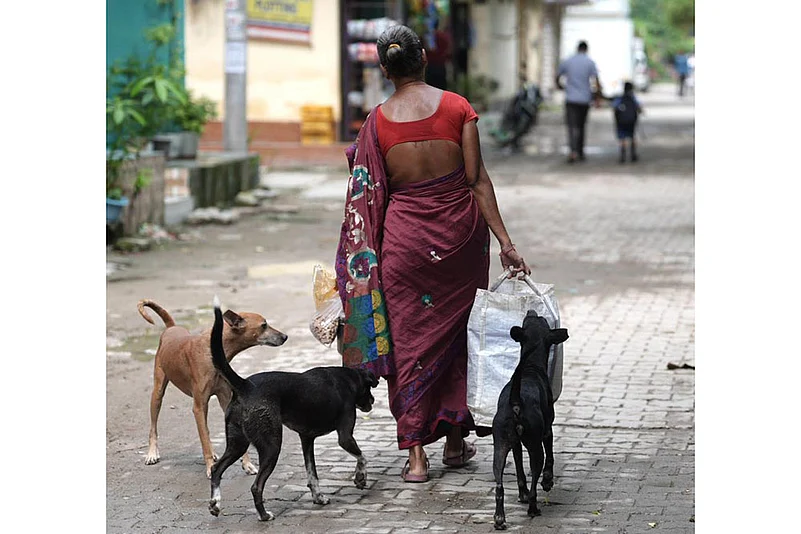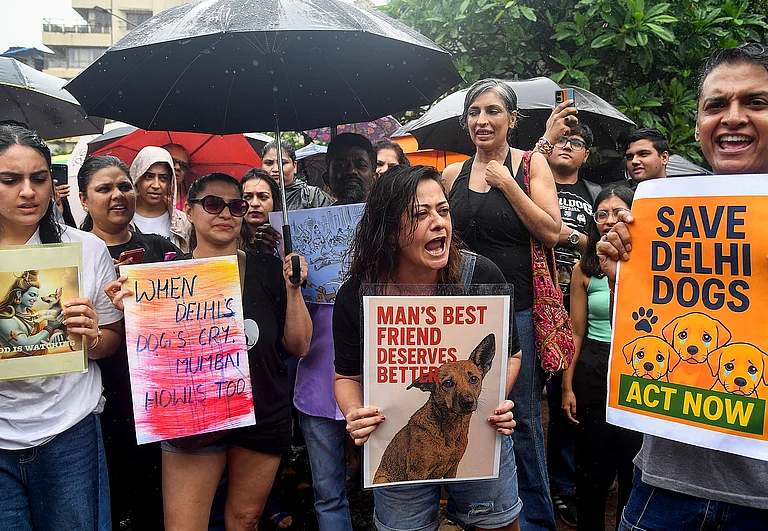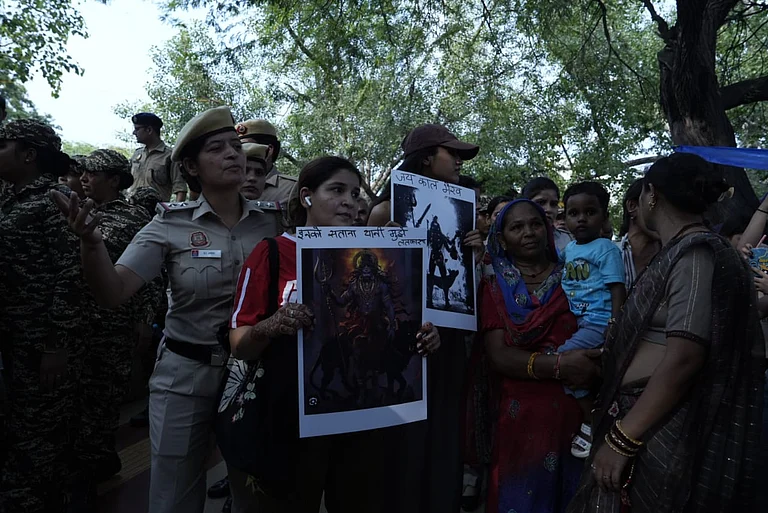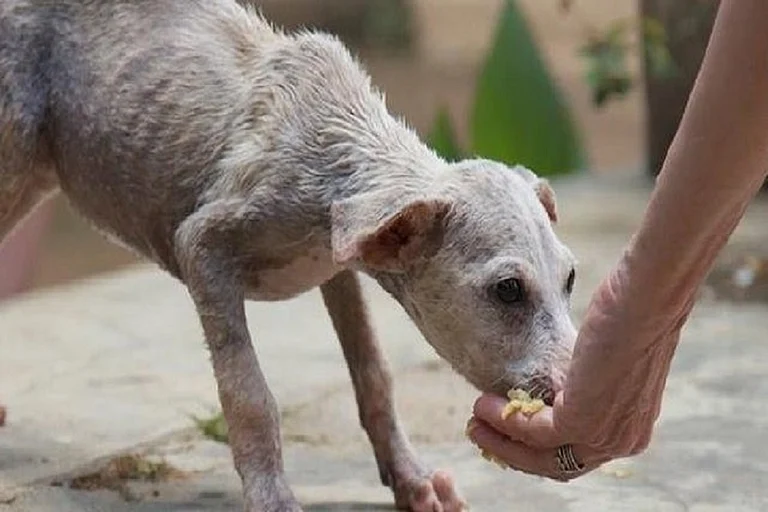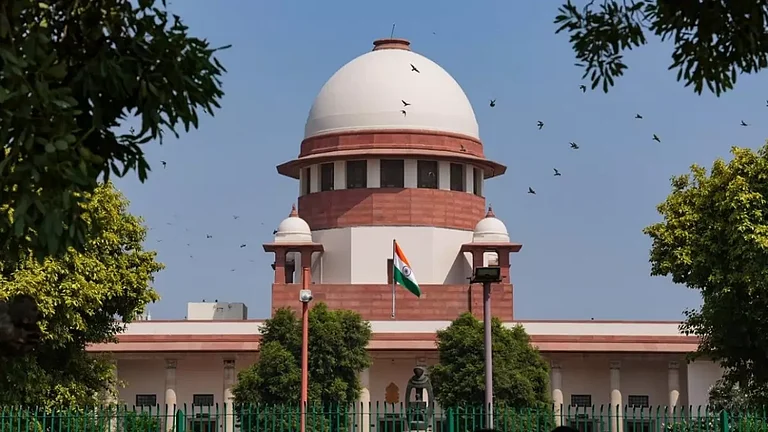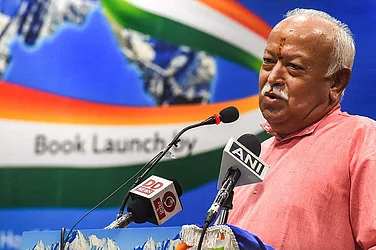
Supreme Court order says stray dogs must go but are all dogs living on streets 'strays'?
Illegal night-time dog roundups are happening, as caregivers struggle to protect them.
Dogs have integrated with humans; let us not sever that bond.
The recent Supreme Court order to clear residential colonies of Delhi of stray dogs as they have been deemed a threat to public safety has drawn a raging debate on and beyond social media. The response of many who are trying to have it reversed or cancelled has been that there is no action plan for what is in store for these dogs once they have been picked up.
With no shelters, arrangements for Animal Birth Control drives, or meals and cover, or even space, for that matter, many advocates for strays claim that the order hasn’t been thought through fully and will be impossible to implement. As valid as this question is, and it is the most serious of concerns, central to the issue is the relocation of strays that is, according to our Constitution, illegal in itself.
When I hear animal advocacy or rights activists on social media, whether on videos circulating on WhatsApp, Instagram or Facebook, most taking a cue from clips shared by the office of the former environment minister, Maneka Gandhi (videos that most rescuers and caregivers, myself included, look to at times like this for some measure of sanity, confidence and support), two comments made by her stand out. In an interview with The Telegraph, she said, “This is a judgement made out of anger.” And she said, “We were expecting something like this anyway.”
While Gandhi rightfully points to the escalating anger within certain sections, that has cumulatively led to the court order of August 11, 2025, its randomness has since led dog-hating sections of the public astray, and rabid with hate comments and hate polls. This, in turn, has led to dogs being illegally picked up by unknown agencies. Vans roaming around in the capital, in the dead of the night, have been picking up stray dogs, many as they safely slept in the human-provided comforts of nooks and corners.
Vans without vehicle registration papers, that don’t belong to the Municipal Corporation of Delhi (MCD), have been picking up dogs, pretending to be dog-catchers though they do not have the required ID or even a copy of the court order to show the caregivers who are trying their best to stop them. They have been standing by their colony dogs in the non-stop downpour lashing the capital over the last few.
In fact, that court order is yet to officially reach the MCD from the apex court, which means strays cannot be thus rounded up, making the action illegal.
One also cannot help but think from recent events that many of us who fight for the right to care for strays are often completely deluded, and naïve. The recurring response from all of us, including ex-minister Gandhi has been to ask, ‘Where are the shelters for Delhi’s ten lakh strays?’ ‘Where will these dogs be housed once they lose their natural habitat?’ ‘What will they be fed, and who will feed them?’ ‘How will ten lakh dogs be vaccinated when the MCD claims it has the wherewithal to vaccinate only 2,500?’ ‘How will ABC drives be conducted in shelters that are yet to be built?’ And most of all, ‘Where is the staggering Rs 500-plus crore a month needed just to feed this many dogs, to be housed in thousands of new shelters that are yet to be built and which will need as many staffers,’ as Gandhi has pointed out?
Shelters require nonstop supplies of water and covered space for Delhi’s winter chill and relentless rains. But to all these questions, there is no official answer, nor a plan of action yet. Yet we know in our hearts as caregivers and rescuers that the court seems to represent the angry sections with a grouse against Delhi’s strays. And the authorities do not care, not even the MCD. It’s that simple.
It is sinister, then, but must be acknowledged that it’s longer about where to send the dogs or how they will be kept alive but how they will be culled.
When provoked, deep rooted hatred and anger can go astray
A deep hatred and envy of street dogs has festered in many sections of city society since the last two decades, as Delhi sprouted thousands of rescuers, fosterers, caregivers. Let’s face it—as Delhiites, we can visibly see significant changes in residential colonies across the capital. Each colony has a pet-rescue or caregiving group. Most Resident Welfare Associations have an empathetic official representative with a pet or two who at least allows timely spots for feeding or conducting ABC drives, or camps and training sessions for those who are scared of strays or don’t have an informed take. There are many who simply don’t understand that they must try to step away from dogs snoozing under awnings or staircases, or that a dog just passing them by can be ignored….
Almost every posh colony in Delhi has feeders and many van services send twice-a-day meals for strays in different localities. Many pet owners have extended their pet families to include one or two, even three, indie rescues, apart from their pedigree pets. Usually, the health of the pedigree improves vastly after the arrival of the hardy and relatively healthier strays, so long as they do not suffer from weakened immunity that the extensive inbreeding of pedigrees causes.
Yet for every battalion of dog lovers, there are two or three or fifteen dog haters– a smaller but aggressive minority that cannot stop complaining about the stray dog ‘menace’, over-zealous in their mockery, making nasty remarks about ‘cynophiles’ who hire walkers to walk adopted strays, which they find amusing, even comic.
Or they complain on WhatsApp groups that rescuers don’t make dog walkers ‘pick up their poop’. To such residents, everywhere they look, they find dog poop—but they never seem to even notice the garbage strewn everywhere. Some mornings, one wakes up to a barrage of messages about ‘highly toxic’ dog poop, and ultimatums to ban them from gardens and green spaces, when dog urine and faeces is actually the best natural urea, especially for gardens and plants.
Night or day, this minority posts on WhatsApp groups about the ‘one particular dog’ they are convinced is dangerous and bites people, posting copiously long texts filled with legalese about it. Incidents and accounts are pulled up of when said dog barked and ‘bit’ someone with many a delivery ‘parcel-walla’ claiming that ‘mujhe woh kutte ne kaata tha’.
Upon checking, it becomes clear that the dog being talked about is no giant but a well-fed and vaccinated long-neutered dog. What such people actually fear is not the dog they see, or think they see, but the canine they recall from their childhood days, lodged in their mind as a recent bite.
Fact is, Delhi has recorded fewer and fewer rabies cases over the last few years. The latest count is 49, and even those are presumptive: where doctors assumed rabies risk, not just from dogs but rats, cows and crows. During the hearing of the three member bench in court on August 14,2025, a judge remarked that he has data showing zero rabies cases in Delhi as of 2025.
Despite an absentee municipal corporation that could be out there spending tax-payer’s money on animal birth control drives and vaccinations, it is Delhi’s army of fosterers, caregivers and rescuers who are doing it all, at their own cost, often with no help from RWAs. They also turn up at rallies and vigils and walks when heinous crimes occur in the capital, when no one defends the capital’s students fighting partisan politics or raising their voice in support of their brothers and sisters in the northeast, fighting genocide or holding vigils for the brilliant minds behind bars... It’s the very same fighters who text each other in the middle of a freezing Delhi winter night to borrow a blanket for a dog with fever, or an e-collar for one with a skin infection. It’s the same bunch who are branded ‘activists’ or snidely called zoophiles or cynophiles.
What the mind doesn’t know, the eye cannot see
One bright, sunny morning during the peak of the Covid-19 pandemic, I was attending to a colony dog I care for in the south east corner of Delhi where I live. Bella had a bad wound and since no vets were being allowed into the colony, I did what all other resourceful rescuers and caregivers to our many community dogs and cats (and birds and monkeys and nilgai) do: call a friendly vet, note down their advice, buy and apply the medications ourselves. I had been told to comb Bella’s coat well, preferably with a wooden neem comb and once the wound had dried, bathe her. It took a few weeks to treat Bella, and over those days, some neighbours would pass us by, masks on, eyes burning behind spectacles piercingly staring at me as I applied ointment, combed, collected the loose fur into a thaila, taking down buckets of water to bathe her, using a hose borrowed from a ground-floor resident kept a tap on to speed up the bath with running water. This happened every single day, as someone would stop at a distance to stare, hand on hip, foot-tapping, saying, “You are doing such a good deed.” “God will bless you.” ”They must be so grateful for you.” “I’m sure it is feeling much better with your care.” And even: “You really have a lot of energy and time and heart, huh?”
To most, a dog is not even a living being. It’s an “it”: a four-legged cursed thing that fell short of good karma in some life time and got stuck with a snout and a tail. Poor “it”. And poor caregivers—they have two legs and two hands, a human brain and capacity to think, and yet they waste their time and money not holding down a job to do due diligence of the four-legged. Something must be wrong with them.
It is automatically assumed that if you devote minutes of your day to caring for strays, you are unmarried, unemployed or both. Or, worse, you have too much time and money.
Come to think of it – stray dogs are so inconsequential that they go unnoticed, especially during festivals like Diwali and Holi, when they helplessly scurry about, searching desperately for a place to hide amid the din and ruckus: nothing short of a war zone for them. Many get lost in the search for a safe corner as they keep running until they find themselves in a new part of the city. But revellers drive around, blasting music from cars, bursting crackers, often setting strays on fire or giving them burns.
What does all this tell us about ourselves? Our relationship with karma seems quite transactional, is it not? Especially when we say things like bathing stray dogs equals god’s blessings, etc. Essentially, it comes down to pity. Joan Didion writes in her remarkable memoir, The Year of Magical Thinking, about self-pity. An oft-repeated line in her memoirs, almost used rhythmically, as if to a beat, is the phrase: ‘The question of self-pity’. (You sit down to dinner and life as you know it ends. The question of self-pity.) She refers to her own unravelling mind seeking self-pity through unrealistic thoughts that connected disparate things in the year after the loss of her middle-aged daughter, Quintana Roo, and her screenwriter husband, John Dunn. Both died in the short span of two years. Sharply critical of her own self-pity, she almost debones every thought and emotion to uncover the facts her body was telling her: the loss of two people central to her life was impacting her brain’s functioning.
That’s how cheap self-pity is—and easy emotion most of us allow ourseves to wallow in when we cannot channel the real deal—that authentic, powerful feeling that asks us to self-assess, examine ourselves, look within instead of outwards. It’s also like when we fail at something repeatedly or are treated shabbily by someone we care about. Pity rises when we are angry with ourselves for allowing us to feel anything when life happens, but not ways we wanted or planned. Pity is what we feel for stray dogs and the growing number of caregivers and rescuers; a tribe whose numbers are growing by the day in Delhi. And why is this happening? For human beings are wired to feel some pretty strong emotions, and yet, often also not wired to deal with them well. Often, when coping mechanisms fail (as when returning to the grind after a tragedy, only to discover you’re having a nervous breakdown), or drives us into toxicity—like we start drinking or using heavily after we lose a parent.
But there is that stray around every corner that, unlike that busy colleague, or snarky friend judging you, makes real eye contact, runs up to you as though its life depended on you, and allows you to give it love, treat it, heal it, all the time loving you back unconditionally, healing you too.
Let’s face it: for many, especially those who cannot afford it, strays are the sole coping mechanism that actually works.
But pity is not empathy. While that colleague or relative or friend may pity your sorry state of affairs, your lost job, or dead family… the strays give you that prized, single shot, megawatt injection of empathy that is like honey, rich and viscous and thick, healing and complex. It takes a lot of kicks and battering to grow empathy in one’s clogged veins and artieries, not just a few break-ups or your boss ignoring you and refusing you a raise. It takes an acute understanding of another being’s emotional state (as opposed to state of mind).
I lost my twenty-two-year-old cat recently, and I would sit down at my desk to write, crying instead, and my indie would show up a minute before I would start to cry, his body sensing my convulsions before even I noticed them. We all know that when humans lose their sense of empathy, operating as they are off the glacial tip of the iceberg of ‘pity’, then anger sits within them like a dormant volcano waiting to burst any minute.
Pity that humans don’t realise that our indies can sense that deep-seated anger too, often withdrawing from the haters on their own, without agencies of the state having to do anything.
The last scene in the Season One finale of the dystopian series with a heart, Paatal Lok, has an unforgettable moment: when the protagonist, a television journalist played by Neeraj Kabi, has a bounty on his head but gets saved from imminent death when the killers learn that his wife rescues strays. The wife, played by Swastika Mukherji, whose character stays awake nights, tending to a pregnant stray (actually worrying whether her husband is safe), says: it is I who is being rescued by caring for the dog, not the other way around.
In JM. Coetzee’s Nobel-Prize winning book, Disgrace, the central character, David Lurie, is thrust from academics after an affair with a student into a corner of South Africa, where he helps his daughter farm, culling hundreds of dogs every day to meet a chilling magic number… The dogs must die because the State won’t have them. They are healthy—but they are dogs—and the socially divided, new African nation state isn’t willing to accept them as its own. So, the answer is to kill them all before the State gets to them.
If they can’t be monetised, they can’t be kept. Dead simple.
In Iranian writer Sadeq Hedayat’s short story, ”The Stray Dog”, a self-destructive society spiralling dangerously towards a dictatorial and patriarchal regime is depicted through the story of a lost pedigree dog of Scottish descent: “Two human eyes shone in his woolly face. A human spirit could be seen in the depths of its eyes.”
In contrast is the mean, sly pettiness that the dog himself is surrounded by, living on a filthy street lined with shops selling meat where even the sycamore is barely alive. “For every groan the dog gave, he would be hit on the side with a stone… It was as if all the others were on the boy’s side, craftily and slyly encouraging him and then doublng up with laughter.”
In the ultimate unravelling of human society, in November 2006, re-publication of Hedayat’s work in its original, uncensored form was banned in Iran as part of a purge.
Are cared-for community dogs ‘stray’?
Calling all street dogs strays is not just contentious but wholly inaccurate. A dog that has lived in a neighbourhood for years, fed by its residents, defending the colony like its own, and vaccinated and treated for routine health issues, and sterilised, would graduate from being the stray it was to a community animal that has a name (probably many if it has more than one carer!). If it has a collar and a patch of garden or a garage to sleep in, perhaps even a bed, is it still a stray? It is no less than another resident, with its own character and mannerisms and good and bad days. We all have that neighbour who barks at their spouse or kid one day, then coos at kids playing in the park. Even our learned judges would know of such people!
After all, canines have melded with the human presence they have surrounded themselves with, whom they guard and protect the best way they can—by occasionally biting a threatening presence or barking in the dead of the night at an intruder or interloper.
To banish them to the gates of hell is a human flaw and failing in dealing with our own anger at the divided, highly polarised society we have created and are now struggling to survive in. Even angry dogs calm down when their irrational fears are assuaged by an empathetic trained human. Ask the trainers, whose profession is prized around the world, if not in India, whose work actually saves human lives.







